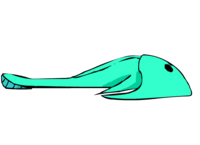Agnatha
Agnatha is a chordate taxonomic group comprising the jawless fish and generally is placed as a superclass within in the subphylum Vertebrata. Agnathans have existed since the Cambrian and continue to be present now, with two extant groups of jawless fish (sometimes called cyclostomes), the lampreys and the hagfish.
Characterized by the absence of jaws derived from gill arches, agnathans are differentiated from the gnathostomes (superclass Gnathostomata), or "jawed vertebrates" (fish with hinged jaws, amphibians, reptiles, birds, and mammals). However, Agnatha generally is considered to be a paraphyletic grouping (Purnell et al. 2001; Nelson 1994).
Overview and classification
Vertebrates (subphylum Vertebrata) are generally classified into two groups, the Agnatha (jawless vertebrates) and the Gnathostomata (jawed vertebrates). The later group includes fish with hinged jaws and the tetrapods (amphibians, reptiles, birds, and mammals). Agnatha (Greek, "no jaws") includes the modern day lampreys (Petromyzontiformes) and hagfish (Myxiniformes) as well as several extinct orders.
In most taxonomies, Agnatha and Gnathostomata are each considered a superclass of Vertebrata, although sometimes Agnatha is considered a class (see taxonomy). In some taxonomies, Agnatha and Osteichthyes are considered superclasses (ITIS 2001) of Vertebrata.
The Agnatha, in addition to including
Hagfish, while generally classified in Agnatha ("jawless") and as fish, actually lack vertebrae. For this reason, hagfish, which are also commonly known as "slime eels," are sometimes not considered to be fish. The other living member of Agnatha, the lamprey, has primitive vertebrae made of cartilage. Hagfish are a staple food in Korea. They are classified in the order Myxini and the family Myxinidae. Both hagfish and lamprey have slimy skin without scales or plates. They also have a notochord that remains throughout life; circular, jawless mouths; and unpaired fins. Hagfish are found in the oceans and lampreys are found in both freshwater and ocean environments. Most lampreys are parasitic.
is a paraphyletic[1] superclass of jawless fish in the phylum Chordata, subphylum Vertebrata.
Although they are in the subphylum Vertebrata, hagfish technically do not have vertebrae; they are sometimes classified in Craniata. In addition to the absence of jaws, Agnatha are characterised by absence of paired fins; the presence of a notochord both in larvae and adults; and seven or more paired gill pouches. There is a light sensitive pineal eye (homologous to the pineal gland in mammals). All living and most extinct Agnatha do not have an identifiable stomach or any appendages. Fertilization and development are both external. There is no parental care in the Agnatha class. The Agnatha are ectothermic, with a cartilaginous skeleton, and the heart contains 2 chambers.
Although they are superficially similar, many of these similarities are probably shared primitive characteristics of ancient vertebrates, and modern classifications tend to place hagfish into a separate group (the Myxini or Hyperotreti), with the lampreys (Hyperoartii) being more closely related to the jawed fishes.
Respiratory System
Agnathans are characterized by seven or more pairs of gill pouches. The bronchial arches supporting the gill pouches lie close to the body surface.
Metabolism
Agnathans are ectothermic or cold blooded, meaning they do not have to warm themselves through eating. Therefore, Agnathan metabolism is slow as well as the fact that Agnathans do not have to eat as much. They have no stomach.
Body covering
The only modern Agnathan body covering is skin. There are no scales. Extinct Agnathans had thick body plates (see below).
Appendages
Agnathans have no paired appendages, although they do have a tail and a caudal fin.
Skeleton
The internal skeleton of the Agnatha is not bony but rather cartilaginous (made up of dense connective tissue). Also, Agnathans have a notochord their whole life, a characteristic distinctive of the class. This notochord is the first primitive vertebral column.
Reproduction
Fertilization is external, as is development. There is no parental care.
Fossil agnathans
Although a minor element of modern marine fauna, Agnatha were prominent among the early fish in the early Paleozoic. Two types of Early Cambrian animal apparently having fins, vertebrate musculature, and gills are known from the early Cambrian Maotianshan shales of China: Haikouichthys and Myllokunmingia. They have been tentatively assigned to Agnatha by Janvier. A third possible agnathid from the same region is Haikouella. A possible agnathid that has not been formally described was reported by Simonetti from the Middle Cambrian Burgess Shale of British Columbia.
Many Ordovician, Silurian, and Devonian agnathans were armored with heavy bony-spiky plates. The first armored agnathans—the Ostracoderms, precursors to the bony fish and hence to the tetrapods (including humans)—are known from the middle Ordovician, and by the Late Silurian the agnathans had reached the high point of their evolution. Agnathans declined in the Devonian and never recovered.
Groups
- Myxini (hagfish)
- Hyperoartia
- Petromyzontidae (lampreys)
- Pteraspidomorphi
- Thelodonti
- Anaspida
- Cephalaspidomorphi
- Galeaspida
- Pituriaspida
- Osteostraci
ReferencesISBN links support NWE through referral fees
- ↑ Purnell, M. A. (2001). in Derek E. G. Briggs and Peter R. Crowther: Palaeobiology II. Oxford: Blackwell Publishing. ISBN 0-632-05149-3.
- Integrated Taxonomic Information System (ITIS). 2003. Agnatha ITIS Taxonomic Serial No.: 159693. Retrieved May 31, 2008.
- Integrated Taxonomic Information System (ITIS). 2001. Vertebrata ITIS Taxonomic Serial No.: 331030. Retrieved May 31, 2008.
- Nelson, J. S. 1994. Fishes of the World, 3rd ed. New York: John Wiley & Sons. ISBN 0471547131.
Credits
New World Encyclopedia writers and editors rewrote and completed the Wikipedia article in accordance with New World Encyclopedia standards. This article abides by terms of the Creative Commons CC-by-sa 3.0 License (CC-by-sa), which may be used and disseminated with proper attribution. Credit is due under the terms of this license that can reference both the New World Encyclopedia contributors and the selfless volunteer contributors of the Wikimedia Foundation. To cite this article click here for a list of acceptable citing formats.The history of earlier contributions by wikipedians is accessible to researchers here:
The history of this article since it was imported to New World Encyclopedia:
Note: Some restrictions may apply to use of individual images which are separately licensed.


